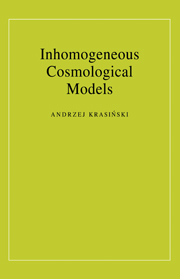Book contents
- Frontmatter
- Contents
- List of illustrations
- Preface
- Acknowledgements
- 1 Preliminaries
- 2 The Szekeres–Szafron family of solutions
- 3 Physics and cosmology in an inhomogeneous Universe
- 4 The Stephani–Barnes family of solutions
- 5 Solutions with null radiation
- 6 Solutions with a “stiff fluid”/scalar field source
- 7 Other solutions
- 8 Averaging out inhomogeneities of geometry and matter in cosmological models
- 9 Comments
- Appendix A Dictionary of abbreviations used in the text and in the diagrams
- Appendix B Why should one consider inhomogeneous models of the Universe?
- Appendix C Memorable statements about the cosmological principle
- Appendix D How was this review compiled?
- Appendix E Historical milestones
- Notes added in proof
- Bibliography
- Index
- Frontmatter
- Contents
- List of illustrations
- Preface
- Acknowledgements
- 1 Preliminaries
- 2 The Szekeres–Szafron family of solutions
- 3 Physics and cosmology in an inhomogeneous Universe
- 4 The Stephani–Barnes family of solutions
- 5 Solutions with null radiation
- 6 Solutions with a “stiff fluid”/scalar field source
- 7 Other solutions
- 8 Averaging out inhomogeneities of geometry and matter in cosmological models
- 9 Comments
- Appendix A Dictionary of abbreviations used in the text and in the diagrams
- Appendix B Why should one consider inhomogeneous models of the Universe?
- Appendix C Memorable statements about the cosmological principle
- Appendix D How was this review compiled?
- Appendix E Historical milestones
- Notes added in proof
- Bibliography
- Index
Summary
Afterthoughts
In addition to justifying the two messages from Section 1.1, the main purpose of this book was to draw together and bring to the readers' attention all those fine and illuminating contributions to relativistic cosmology that do not fit into the “standard model”, while still not negating its applicability as a first approximation. Hopefully, the book has proved that these contributions are not phantasies of isolated individuals, but that, taken together, they do tell us about interesting processes that might be going on in the Universe – processes that we would not even suspect using the FLRW models alone. The results presented highlight several problems in the current system of education and research in physics.
The first problem is the highly dogmatic approach of astronomers towards the “standard model” and other “standards”. It seems that the hypothetical, provisional character of the assumptions that lead to the FLRW models has not been given sufficient emphasis in astronomy courses. As a result, the homogeneity and isotropy of the Universe are treated by many (most?) astronomers as a revealed truth, never to be questioned. This author has sometimes experienced outright aggression during seminars and conference talks, while presenting the various ideas that now appear in this book. Physicists do not seem to suffer from this problem, but astronomers would be well advised to treat the “current knowledge” in a more relaxed way, especially in view of the still highly unsatisfactory reliability and precision of most observations and the numerous changes in the apparently well-established results.
- Type
- Chapter
- Information
- Inhomogeneous Cosmological Models , pp. 276 - 277Publisher: Cambridge University PressPrint publication year: 1997

